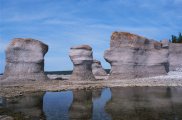
Worksheets and No Prep Teaching Resources
Reading Comprehension Worksheets
Earth Science

Earth Science
 Worksheets and No Prep Teaching Resources Reading Comprehension Worksheets Earth Science |
 Earth Science |
| edHelper's suggested reading level: | grades 9 to 10 | |
| Flesch-Kincaid grade level: | 8.93 |
| Print Rates of Weathering (font options, pick words for additional puzzles, and more) |
| Quickly print reading comprehension |
| Print a proofreading activity |
|
Rates of Weathering
By Trista L. Pollard |

|
 1 As dramatic as the process of weathering sounds, it does not happen overnight. In fact, some instances of mechanical and chemical weathering may take hundreds of years. An example would be the dissolving of limestone through carbonation. Limestone dissolves at an average rate of about one-twentieth of a centimeter every 100 years. If you want to see a layer of limestone (about 150 meters thick) dissolve, plan on watching that layer for about 30 million years.
1 As dramatic as the process of weathering sounds, it does not happen overnight. In fact, some instances of mechanical and chemical weathering may take hundreds of years. An example would be the dissolving of limestone through carbonation. Limestone dissolves at an average rate of about one-twentieth of a centimeter every 100 years. If you want to see a layer of limestone (about 150 meters thick) dissolve, plan on watching that layer for about 30 million years. |
Create Weekly Reading Books
Prepare for an entire week at once! |
| Leave your feedback on Rates of Weathering (use this link if you found an error in the story) |
 |
Earth Science
|
 |
High School Reading Comprehensions and High School Reading Lessons
|